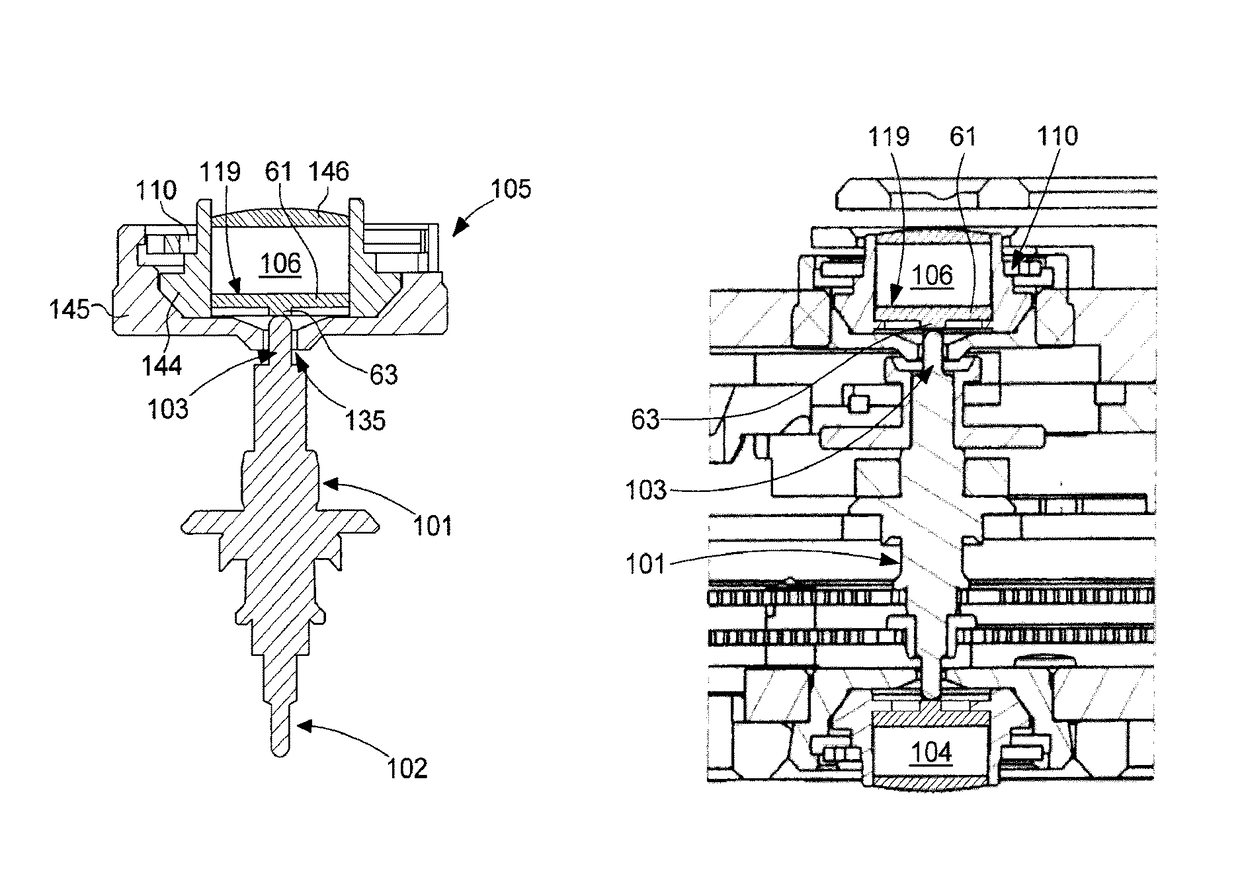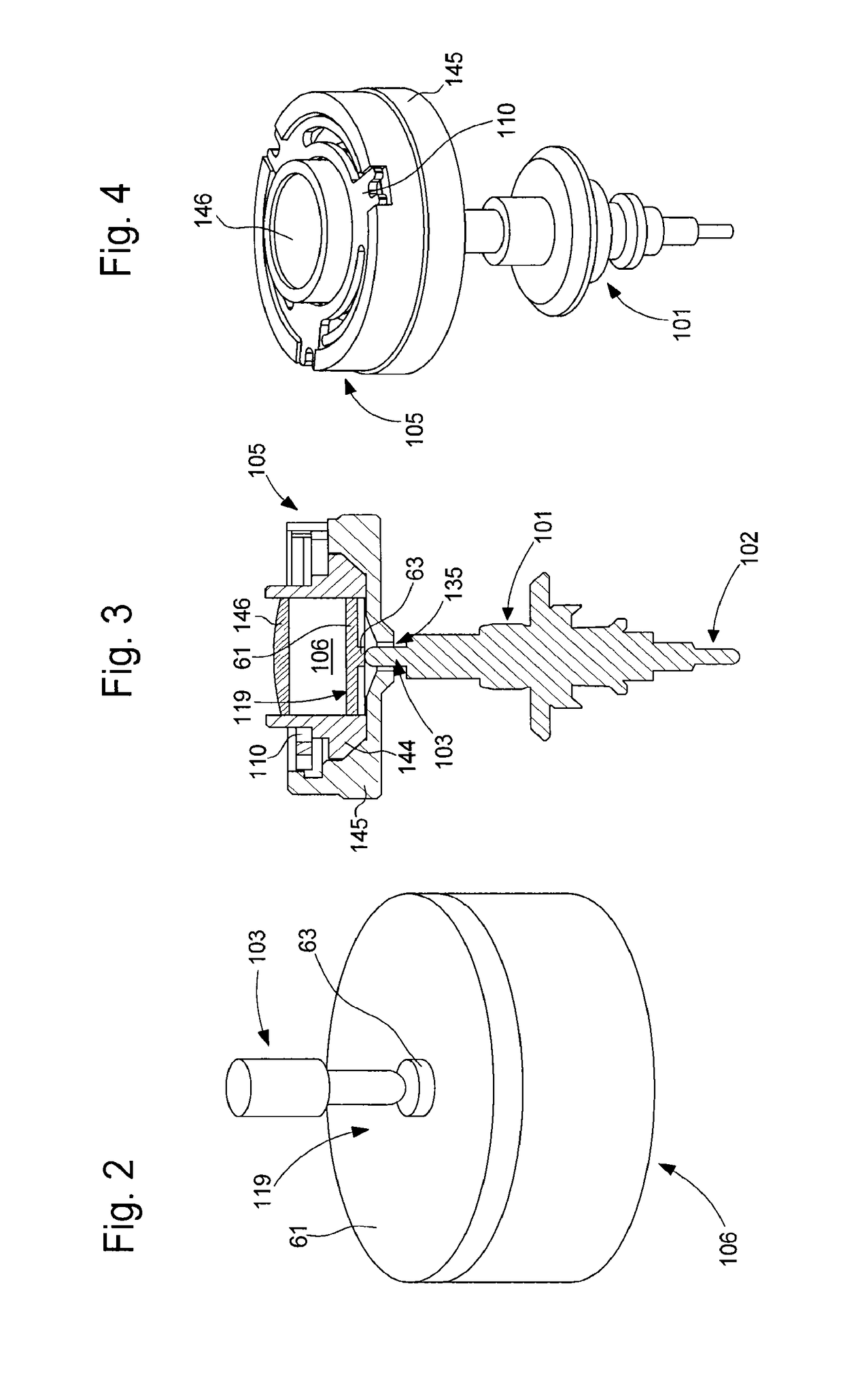Magnetic device for pivoting an arbor of a rotating member in a timepiece movement
a technology of rotating parts and magnetic devices, which is applied in the direction of magnetic bearings, instruments, and reliable timepiece mechanisms that operate in accordance, and can solve the problems of difficult control of positioning and intensity of magnetic fields on this scale, reducing dimensions, and reducing so as to reduce the risk of damaging the magnetic field produced by the magnet. , the effect of less restriction
- Summary
- Abstract
- Description
- Claims
- Application Information
AI Technical Summary
Benefits of technology
Problems solved by technology
Method used
Image
Examples
first embodiment
[0030]Referring now more specifically to FIGS. 3, 4 and 5, a design variant will now be described in more detail for the invention. This embodiment corresponds to an anti-shock pivoting device.
[0031]The illustrated pivoting device includes an arbor 101 whose ends form two pivots, respectively referenced 102 and 103. Pivot 103 is made of a magnetic material. The Figures also show a first bearing 105 including a magnet 105, arranged to support and guide in rotation pivot 103, and a second bearing including a magnet 104 similar to the first bearing.
[0032]Hereinafter there will be described only the first bearing, which includes a setting 144, a bearing jewel 146 abutting against the bottom of the setting, a permanent magnet 106 mounted in the setting against the bearing jewel, and a pole structure 119 inserted between the magnet and the opening of the setting. In the illustrated example, bearing jewel 146 has no technical function other than closing the bottom of the setting and acting...
third embodiment
[0039]It will be understood that frame 361 and arms 365 can be formed of the same material as the actual endstone. In such case, the presence of an annular space between the endstone and the frame prevents the pole structure forming a shield returning the field lines back towards the other pole of the magnet. Thus, the third embodiment makes it possible to have a thicker, and thus more solid frame, even if it is made of the same material as the endstone. Alternatively, frame 361 and arms 365 may be made of a different material from that forming the endstone.
[0040]Referring more specifically now to FIG. 8A, it can be seen that the pole structure shown includes a frame 371 and an endstone 73 connected to each other by four connecting elements 375. As can be seen, the connecting elements illustrated are in the form of small bars bent in an arc of a circle. It will be understood that, in the variant shown, the curvature of small bars 375 forms a resilient connection between the central ...
fourth embodiment
[0042]FIG. 9 is a partial longitudinal cross-sectional view illustrating a bearing of a pivoting device corresponding to the invention. One peculiarity of this latter embodiment is that the pole structure does not have a peripheral frame but is limited to an endstone whose dimensions, in cross-section to the pivot axis, are smaller than those of the magnet. In the Figure there is seen a magnet 406 and an endstone 463 which is bonded directly onto the magnet. The endstone is formed, according to the invention, of a magnetic material having good tribological properties.
PUM
 Login to View More
Login to View More Abstract
Description
Claims
Application Information
 Login to View More
Login to View More - R&D
- Intellectual Property
- Life Sciences
- Materials
- Tech Scout
- Unparalleled Data Quality
- Higher Quality Content
- 60% Fewer Hallucinations
Browse by: Latest US Patents, China's latest patents, Technical Efficacy Thesaurus, Application Domain, Technology Topic, Popular Technical Reports.
© 2025 PatSnap. All rights reserved.Legal|Privacy policy|Modern Slavery Act Transparency Statement|Sitemap|About US| Contact US: help@patsnap.com



